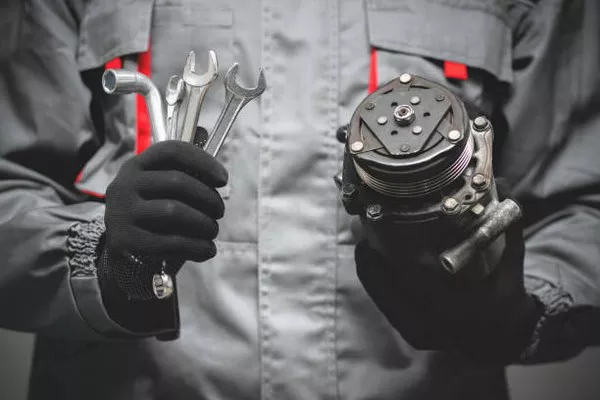Sandblasting, also known as abrasive blasting, is a powerful method used to clean, smooth, or etch surfaces. This technique utilizes an air compressor to propel abrasive materials against a surface at high speeds. In this comprehensive guide, we will explore how to use an air compressor for sandblasting, covering essential equipment, safety precautions, techniques, and maintenance tips.
What is Sandblasting?
Definition
Sandblasting is a process that involves forcibly propelling a stream of abrasive material against a surface under high pressure. This method is commonly used in various industries for surface preparation, cleaning, and finishing.
Common Applications
Surface Preparation: Cleaning metal surfaces before painting or coating.
Restoration: Removing rust, paint, or old finishes from various surfaces.
Etching: Creating designs or patterns on glass or stone.
Deburring: Smoothing edges on machined parts.
Understanding Air Compressors
Types of Air Compressors
When it comes to sandblasting, not all air compressors are created equal. Here are the most common types suitable for sandblasting:
Reciprocating Compressors: These are piston-driven and typically provide high pressure, making them ideal for sandblasting applications.
Rotary Screw Compressors: These compressors are more efficient for continuous use but can be more expensive.
Key Specifications
When choosing an air compressor for sandblasting, consider the following specifications:
CFM (Cubic Feet per Minute): This measures the volume of air the compressor can deliver. Most sandblasting applications require a CFM rating between 5 and 20, depending on the nozzle size and type of abrasive material used.
PSI (Pounds per Square Inch): This indicates the pressure at which the air is delivered. Sandblasting typically requires a PSI of at least 90 to 120.
Essential Equipment for Sandblasting
1. Air Compressor
Choose a compressor with adequate CFM and PSI ratings for your sandblasting needs. Ensure it has a sufficient tank size to avoid frequent cycling during operation.
2. Sandblasting Kit
A sandblasting kit typically includes:
Sandblasting Gun: The tool used to propel the abrasive material.
Hoses: Durable hoses that can withstand high pressure.
Nozzles: Different sizes for varying levels of abrasiveness.
3. Abrasive Material
Common abrasive materials include:
Silica Sand: Widely used but can be hazardous to health. Use with caution and appropriate safety measures.
Aluminum Oxide: A harder material suitable for various applications.
Garnet: A more environmentally friendly option that produces less dust.
4. Protective Gear
Always wear protective gear to safeguard against flying debris and inhalation of harmful particles. Essential protective equipment includes:
Respirator Mask: To protect against inhaling dust.
Safety Goggles: To shield your eyes from debris.
Gloves: To protect your hands.
Coveralls: To shield your skin and clothing.
Setting Up for Sandblasting
1. Prepare the Workspace
Choose a well-ventilated area, preferably outdoors or in a designated blasting room. Ensure the workspace is free from obstructions and hazards.
2. Set Up the Air Compressor
Location: Place the compressor close to your work area but at a safe distance to minimize noise and vibrations.
Connections: Connect the air hose from the compressor to the sandblasting gun. Ensure all connections are tight to prevent leaks.
3. Load the Abrasive Material
Choosing the Right Abrasive: Select the appropriate abrasive material based on your project requirements.
Filling the Hopper: Pour the abrasive material into the sandblasting gun’s hopper. Ensure it’s filled adequately to allow for continuous blasting.
Operating the Sandblasting System
1. Adjust the Air Pressure
Set the air compressor to the recommended PSI for your specific sandblasting gun. Typically, this ranges from 90 to 120 PSI. Adjust as necessary based on the desired effect.
2. Test the Setup
Before starting the actual sandblasting, perform a test on a scrap piece of material to ensure proper operation. This step will help you adjust the nozzle distance and angle.
3. Start Sandblasting
Hold the Gun: Grip the sandblasting gun firmly and position it at a 45-degree angle to the surface.
Maintain Distance: Keep the nozzle at a consistent distance from the surface, typically 6 to 12 inches, to achieve an even finish.
Move Smoothly: Use a sweeping motion to move the gun across the surface, maintaining a steady pace for uniform results.
Safety Precautions
1. Ventilation
Ensure adequate ventilation in the workspace to reduce inhalation of harmful dust particles.
2. Wear Protective Gear
Always wear the appropriate safety equipment, including a respirator, goggles, and gloves.
3. Be Aware of Surroundings
Ensure that no one is in the immediate vicinity of the sandblasting area. Use barriers or warning signs if necessary.
Maintenance of Sandblasting Equipment
1. Regular Cleaning
After each use, clean the sandblasting gun, hoses, and other components to prevent clogs and damage.
2. Inspect for Wear
Regularly check hoses, nozzles, and fittings for wear and tear. Replace any damaged components immediately.
3. Drain the Air Tank
Drain any moisture that may accumulate in the air tank to prevent rust and maintain efficiency.
Common Issues and Troubleshooting
1. Low Pressure
If you experience low pressure, check for leaks in the hoses and fittings. Ensure the compressor is operating at the correct PSI.
2. Inconsistent Abrasive Flow
If the abrasive material is not flowing smoothly, check for clogs in the hopper or nozzle. Clean as necessary.
3. Excessive Dust
If dust is excessive, consider using a different abrasive material or adjusting the air pressure.
Conclusion
Using an air compressor for sandblasting can be an effective way to clean and prepare surfaces for various applications. By understanding the necessary equipment, setting up your workspace properly, and following safety precautions, you can achieve professional results. Regular maintenance and troubleshooting will ensure your sandblasting setup remains efficient and effective. Whether you’re a DIY enthusiast or a professional, mastering the art of sandblasting can enhance your project outcomes significantly.
Related topics:

